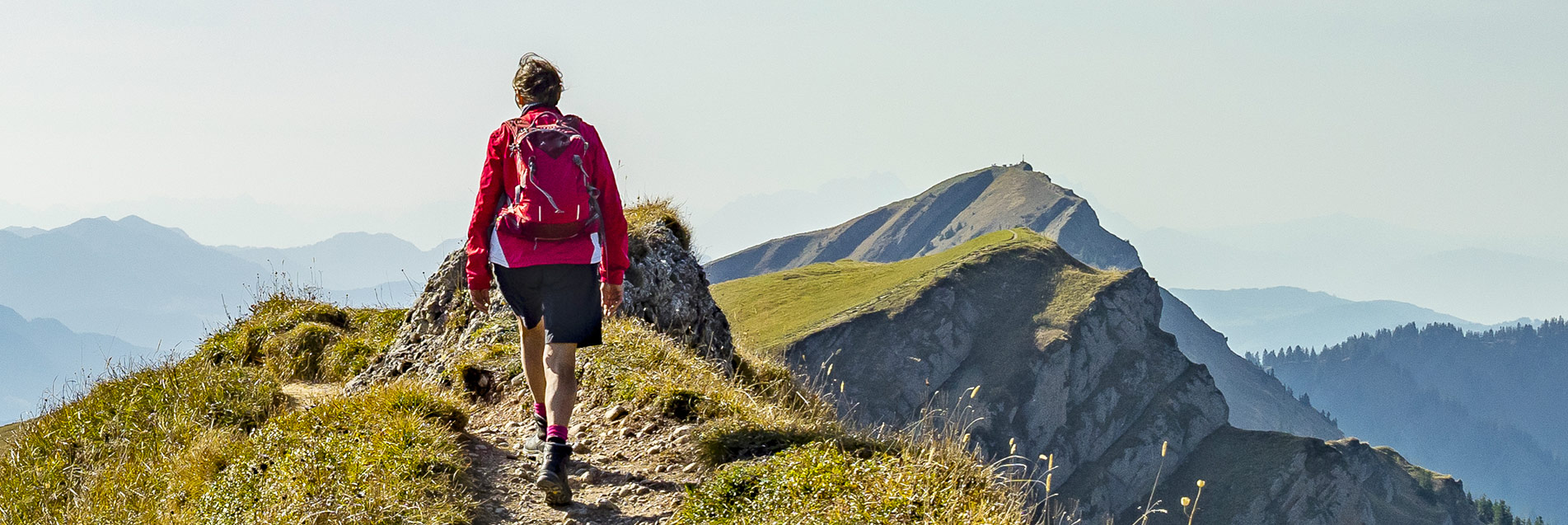Small Group Experiential Travel
Tour Code
bv1
Start
La Paz (LPB)
End
La Paz (LPB)
Tour type
Max Group Size
18
When To Go
Activity Level
Overnight in
- Overview
- Info & Inclusions
- Itinerary
- Map & Hotels
- Photos
- Dates & Prices
Price includes
- Breakfast daily, several lunches, and most dinners (hotels & local restaurants) as per the tour itinerary.
- All transport (including internal flights), accommodation, sightseeing and entrance fees for sites noted as 'visited' in the detailed itinerary.
- Gratuities for local guides, drivers, restaurant staff, porters.
- Domestic flights via local scheduled carriers as per the itinerary.
- Airport transfers for land & air customers.
Exclusions
- International airfare to/from the tour.
- Tour Leader gratuities, lunches, some dinners (per the tour itinrary), drinks, personal items (phone, laundry, etc), international (if applicable), visa fees/departure taxes, any excursions referenced as 'optional'.
- Airport transfers for Land Only customers.
- Our post-reservation trip notes offer further guidance on optional meal costs, entry requirements, and shopping.
Trip Info
- Seasonality and Weather:
This tour is offered twice a year: In Bolivia, the start of the dry season from April-May, has fewer crowds and still feels fresh from the recent rains. Oct-Nov are also dry but a bit warmer, as spring approaches and crowds disperse. Overall, these are two of the best times to visit this destination, outside of the rains which can create problems for travelling, and before the height of summer when it can be hot in some locales. - Transport and Travel Conditions:
Ground transport in and around La Paz provided by private air-conditioned motor coach, 24-36 seats depending on ultimate group size (see 'group size'). Though we will have some full travel days, roads are generally in good condition (rougher in the Altiplano) though a little winding on some stretches. In the Alitplano, we'll be divided between several comfortable 4x4 vehicles.
We feature numerous optional walking opportunities and walking tours on uneven surfaces. This tour is not strenuous in terms of physical activities, but in order to fully enjoy and experience the sites visited, you must be prepared for considerable walking at a leisurely pace.
Larger hotels generally provide baggage handling, but you must still be independent with your luggage at smaller hotels outside of major towns/cities.
We also have a couple of internal flights via domestic carriers, which can in itself be fatiguing (you will have to be able to manage your luggage). This is definitely a full itinerary with plenty of moving around!
One important consideration is the time spent at high altitude. We will be above 3100m/10,000 and, in some locations, above 3600m/12,000 ft. Travellers with pre-existing medical conditions should consult their physician; we will visit some very remote locations with limited access to healthcare. As such, all travellers will be required to complete a medical "self-assessment" form in order to affirm their suitability. To preview this form, please click on the "Resources" tab at the top of this page.
Our "Level 2" rating refers to the overall ambitious nature of the program, the tremendous amount of moving around we do, some early starts and full days of travel and activities, leisurely walks at sites and short walks to dinner, and time spent at high elevation.
Am I suitable for this tour? Please refer to our self-assessment form - Accommodation:
Well-located, air-conditioned/heated, mid-range hotels and inns in towns and cities and of a simpler standard in remote places (ie Uyuni area). All hotels have en suite toilet and bath. Porter service is usually available (see 'inclusions') though you should be independent with your luggage, especially at airports and smaller hotels. Single rooms are limited in number and likely smaller than twins.
* Please click on "Map & Hotels" tab for more information. Note that some of our preferred hotels in La Paz rate themselves 5-star based on a local rating system; internationally, they might be considered more of a 4-star.
Please click on "Map & Hotels" tab for more information - Activity Level: 2
These are particularly busy tours that feature a lot of moving around, sometimes by train and short journeys on local transport. Walking tours of towns and cities are leisurely but you should be prepared to be on your feet for several hours. Some of our cultural trips that occur at high altitude and/or require greater independence with baggage handling (at hotels, airports, train stations) also fall into this category.
To learn more about the Activity levels, please visit our tour styles page. - Staff and Support:
Tour Leader throughout, local guides at several locations, multiple drivers. - Group Size:
Maximum 18 plus Tour Leader
Download Itinerary
- Day 1:Arrival in La Paz, BoliviaToday we arrive in the city of La Paz, one of the world's highest major cities, located at 3686 m (12,090 ft) above sea level. La Paz is situated in a bowl-shaped canyon in the Cordillera Real (Royal Range) of the Andes. As one travels across the Altiplano, the ground suddenly drops away 400 m (1,312 ft) to reveal the city hidden in a bowl in the mountains.
We suggest that you take it easy today in order to Acclimatize to the high elevation (if your flight arrives late today, you might consider arriving a day early in order to rest).
Overnight in La Paz.
Included Meal(s): Dinner - Day 2:La Paz: City TourLa Paz is rightfully famous for its mountain setting; indeed the mountains surrounding La Paz soar to an average of 5500m (18,040 ft) above sea level. The most spectacular views of the city come on a clear evening when one can see the twinkling lights of the city stretching up the hillsides, under the snow-capped triple peak of Mount Illimani at 6402 m (21,000 ft).
Today we'll explore the well-preserved Spanish colonial quarter of the city where we will visit the Precious Metals Museum and the Murillo Museum. Our tour continues to Plaza Murillo where the Cathedral, the Government Palace, and the National Congress buildings are located.
Later we walk through the unusual Mercado de los Brujos, better known as the Witch's Market, where you will see all sorts of potions, herbs, and folk remedies used to guard against evil spirits; the market provides a fascinating window on the secretive world of Andean mysticism. Here (and elsewhere) you may observe the colourfully-dressed native Quechua and Ymara-speaking people. The women wear many layers of petticoats covered by a colourful dress, and over their shoulders they sling a multi-coloured striped blanket called a 'phulla' in which they carry their groceries or babies -- or both! On their heads they wear a bowler hat (which always appears to be too small) at a jaunty angle. The British brought the bowler hat to Bolivia when they were building the railway and somehow it became part of the everyday dress of Andean women.
A must in La Paz is to take a ride on the city's iconic cable car, from which we enjoy fantastic views. We finish today's tour with a visit to the spectacular Valley of the Moon, named for its bizarre geological formations.
Overnight in La Paz.
Included Meal(s): Breakfast and Dinner - Day 3:La Paz: Lake Titicaca & Isla del SolAn early start today takes us to Copacabana, site of religious pilgrimage, beginning with the Incas. Every year, hundreds of thousands of pilgrims travel from distinct parts of Bolivia and other Latin American countries to take part in religious festivals in Copacabana. Legend says that if the statue is removed Lake Titicaca will rise up and flood the whole Altiplano region.
After a brief visit, we board a catamaran for our exploration of Lake Titicaca and Isla del Sol. This is the most important of the thirty-six islands in the lake. Lake Titicaca, South America's largest lake, straddles the Bolivia-Peru border and is said to be the highest navigable body of water in the world at an altitude of 3810 m (12,497 ft). Lake Titicaca was once much larger than the 8560 sq kilometres (3,305 square mi) it occupies today; indeed the great city of Tiahuanaco was built at the edge of the lake, but today it is more than 25 km (15 mi) from the lake! This reduction in the lake size has had a tremendous effect on the climate of the Altiplano region over the past 1,000 years and has made this cradle of cultures able to support far fewer people today.
Our itinerary continues with a stop at the Inti Wata Cultural Complex, which includes several sections with informative displays on traditional medicine, traditional living, and reed ship building. The complex also includes a unique sailing experience aboard a huge traditional reed vessel for a panoramic visit to the Pilkokaina Inca Palace.
We return to the catamaran for a buffet lunch on board, after which we make our way back to La Paz. Please note that, due to our early start, large lunch, and possible early start tomorrow, we do not include dinner this evening.
Overnight in La Paz.
Included Meal(s): Breakfast and Lunch - Day 4:La Paz: Tiwanaku RuinsToday we visit the epic city of Tiwanaku, the capital of an ancient civilization and Unesco site, located 72 km away from the city of La Paz near the south-eastern shores of Lake Titicaca.
The Tiwanaku Empire (also Tiahuanaco or Tihuanacu) was one of the first imperial states in South America, dominating portions of what is now southern Peru, northern Chile, and eastern Bolivia for approximately six hundred years (500–1100 CE). During its greatest times, Tiwanaku was the largest city in the world and considered to be the cradle of all American civilizations. The city lies in the high river basins of the Tiwanaku and Katari rivers, at altitudes between 12,500–13,880 feet (3800-4200 meters) above sea level. Despite its location at such a high altitude, and with frequent frosts and thin soils, perhaps as many as 20,000–40,000 people lived in the city at its heyday.
After 700 years, the Tiwanaku civilization disintegrated as a regional political force. This happened about 1100 CE, and resulted, at least one theory goes, from the effects of climate change, including a sharp decrease in rainfall. There is evidence that the groundwater level dropped and the raised field beds failed, leading to a collapse of agricultural systems in both the colonies and the heartland. Whether that was the sole or most important reason for the end of the culture is debated.
On our tour we will visit the Kalasasaya (Sun) temple, the semi-subterranean Earth Temple, the Akapana Pyramid, and the legendary Sun Gate. Our tour also takes us to the museum featuring ceramic objects and tools from civilizations prior to the Incas.
Return to La Paz.
Overnight in La Paz.
Included Meal(s): Breakfast and Dinner - Day 5:La Paz - Fly to Sucre - Parque Cretacico - SucreThis morning we fly to Sucre, the most beautiful city in Bolivia.*
Whether you call it Sucre, La Plata, Charcas, or Ciudad Blanca, the city of Sucre has a rich, varied history and a wealth of historical architecture deserving of its selection as a World Heritage Site by UNESCO. Sucre shares capital city status with La Paz as the legislative and administrative capital. This is the constitutional capital and home of the Supreme Court; it is also a university city with many cultural attractions. Sucre is also home to a large indigenous population who maintain their traditional clothing and customs and sell their crafts and goods available in the markets.
We begin our day with a visit to a relatively new attraction -- a set of dinosaur tracks (Parque Cretacico), discovered by accident in 1994 in a cement quarry 10 km (6 mi) from the city. The tracks are almost 70-million years old, from the Cretaceous era when a diverse population of dinosaurs were living on and stomping around in, the soft clay shores of a vast ocean inlet which covered large areas of Argentina, coming as far inland as Sucre.
After a break for lunch, we'll tour Sucre, visiting the House of Freedom Historical Museum and the Treasure Museum (Museo del Tesoro), with its displays of precious and semi-precious stones. We also include the the Asur Textile Museum and the outer facades of the churches of San Lazaro and Santo Domingo, the main historical monuments and Bolivar Park.
* Please note that this will likely be a "painfully" early departure owing to the lack of flights (one morning, one late afternoon). Though not ideal, a morning flight serves our purposes/itinerary better than the alternative. Please also note that the changeability of internal flight times over the next (up to and including our flight to Asuncion) could result in adjustments to the final itinerary.
Overnight in Sucre.
Included Meal(s): Breakfast, Lunch and Dinner - Day 6:Sucre - Potosi - ColchaniThis morning we continue by road to Potosi (+/- 3 hours), a UNESCO World Heritage Site. The discovery of ore in silver-rich Cerro Rico ('rich hill') by Indian, Diego Huallpa, in 1544 prompted the foundation of the city of Potosi on April 10th, 1545 at the foot of the hill. At that time more than eighty-six churches were built and the city's population increased to nearly 200,000, making it one of the largest and wealthiest cities in Latin America and in the world. Potosi sits at an altitude of 4090m (13,500 ft) above sea level, and claims to be the highest city in the world. The area is well-known for its cool weather and sometimes even freezing rain!
On arrival we'll visit the city's principal sites, including San Lorenzo Church, where we will appreciate its beautiful façade. We'll admire the exterior of the Arch of Cobija and see the artisans' market in the colonial area of the city.
We'll also visit the Casa Nacional de la Moneda (National Mint),* one of two built to mint the silver coins used by the Spanish Empire. This impressive facility operated until 1953, or lasted for 400 years of continuous coinage. Most of the silver shipped through the Spanish Main came from Potosi. According to official records, 45,000 tons of pure silver were mined from Cerro Rico from 1556 to 1783. In Spanish there is still a saying, valer un potosi, "to be worth a potosi" (that is, "a fortune"). One theory holds that the mint mark of Potosi (the letters "PTSI" superimposed on one another) is the origin of the dollar sign.
After completing our tour of Potosi, we will continue onto our hotel in Colchani.
* We regret if our flight-driven itinerary changes closer to departure have us visiting places on a Sunday when some sites may be closed.
Overnight in Colchani.
Included Meal(s): Breakfast and Dinner - Day 7:Uyuni: Area SightseeingIn the environs of Uyuni we will experience the highest and largest salar (salt lake) in the world (10000 sq km), surrounded by an impressive otherworldly landscape. On the lake's edge, visitors can see the local inhabitants extracting salt using ancient methods. En route we visit the villages of Chaquila and TikaTika.
After a lunch break, we visit the old railway depot in Uyuni, after which we continue to Colchani to see the artisans working on iodized salt. We visit to Incahuasi Island, located in the heart of the salt flat and the biggest of a group of islands that represents an isolated ecosystem. The island is populated with giant cacti species that measure up to 12 meters high (26.25 feet), providing an impressive overview.
Our hotel, located near Colchani village, is a regular facility with rooms, beds, a lobby and a dining room. Only one thing sets this hotel apart -- it's entirely made of salt! (Please don't lick the walls). After dinner you can stroll in the surroundings of the hotel and enjoy the stars in the unpolluted and cloudless skies.
Overnight in Colchani.
Included Meal(s): Breakfast, Lunch and Dinner - Day 8:Salar Uyuni Area SightseeingToday's 4x4 excursion takes us to the north side of Uyuni Salt Flat, where we take a look the Coquesa Mummies, human archeological remains in a little cave near to Tunupa Volcano. Ceramic, gold and copper artifacts, and articles of clothing have been discovered at some of the sites, indicating the presence of an advanced but little-known culture. Unfortunately, the sites' remoteness has left them vulnerable to amateur treasure hunters who have plundered several items of archaeological value.
As our visit coincides with the dry season (April to November), the salt flat surface provides the opportunity to play with photography and the salar's unique perspective.
We return to Colchani for overnight.
Included Meal(s): Breakfast, Lunch and Dinner - Day 9:Uyuni - Fly to La PazToday we fly back to the capital.
As some of your fellow travellers may be continuing to our tour of Paraguay, Uruguay, and Argentina, this flight will occur without your Tour Leader. If so, you will be met on arrival by a local guide, who will also see to your departure arrangements tomorrow. Dinner on your own this evening.
Overnight in La Paz.
Included Meal(s): Breakfast and Dinner - Day 10:DepartDeparture from La Paz.
BUEN VIAJE!
Regions Visited:
Countries Visited:
Countries Visited:
*The red tour trail on the map does not represent the actual travel path.
The following is a list of sample hotels at some locations included on this tour. The hotels shown here are meant to provide a general sense of the standard of hotel we usually aim for; they are not necessarily confirmed for your chosen departure.
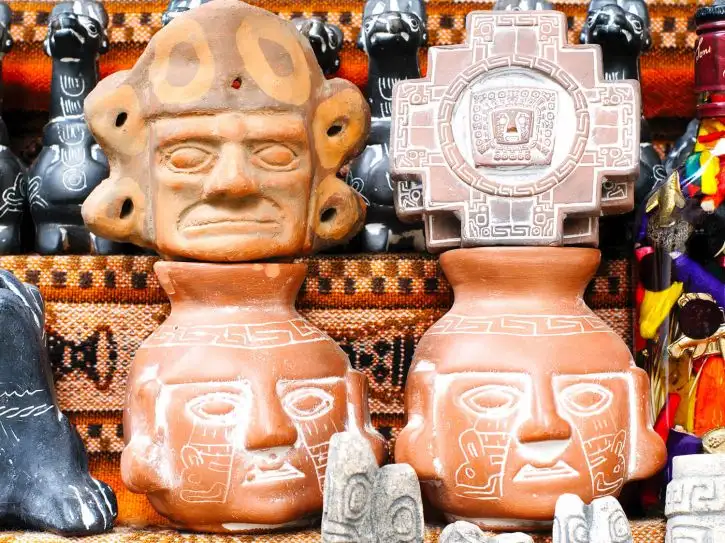
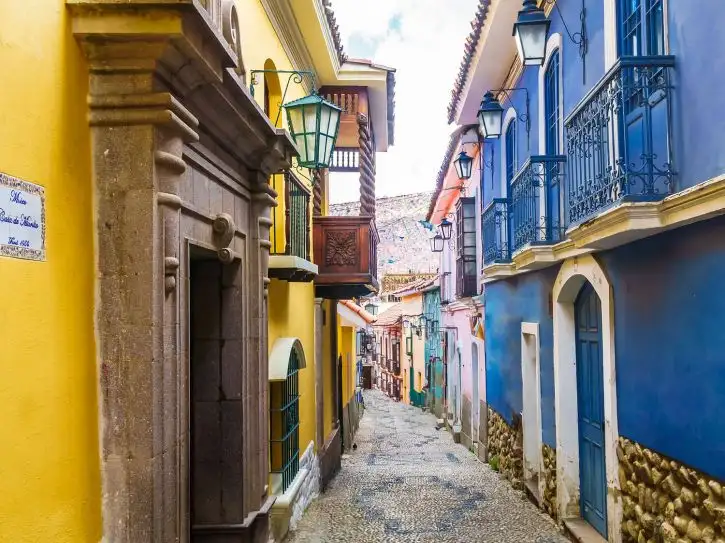
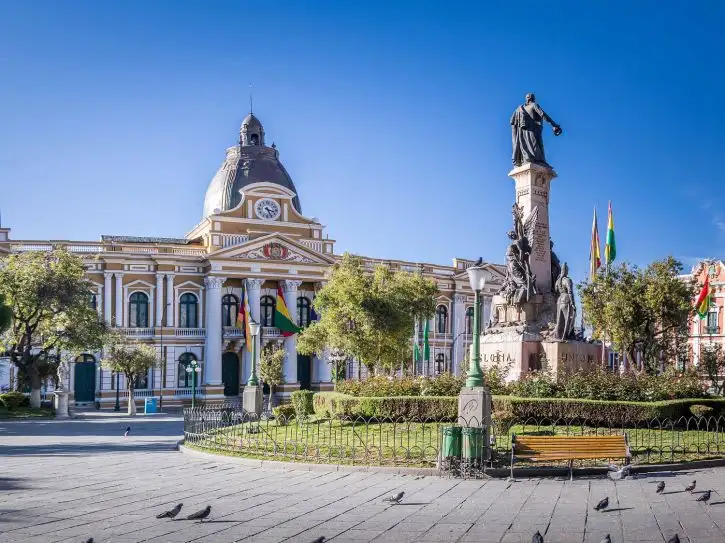
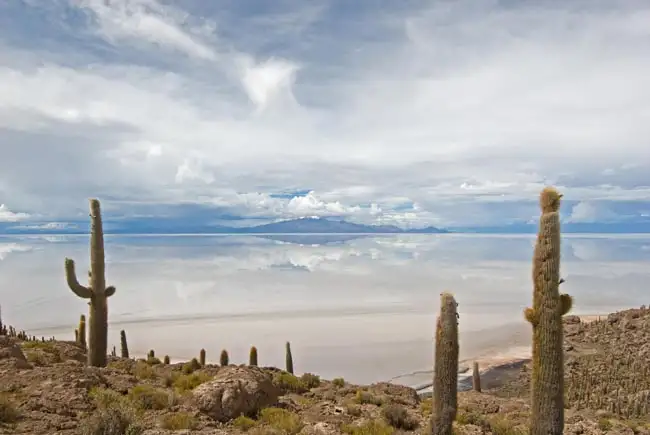
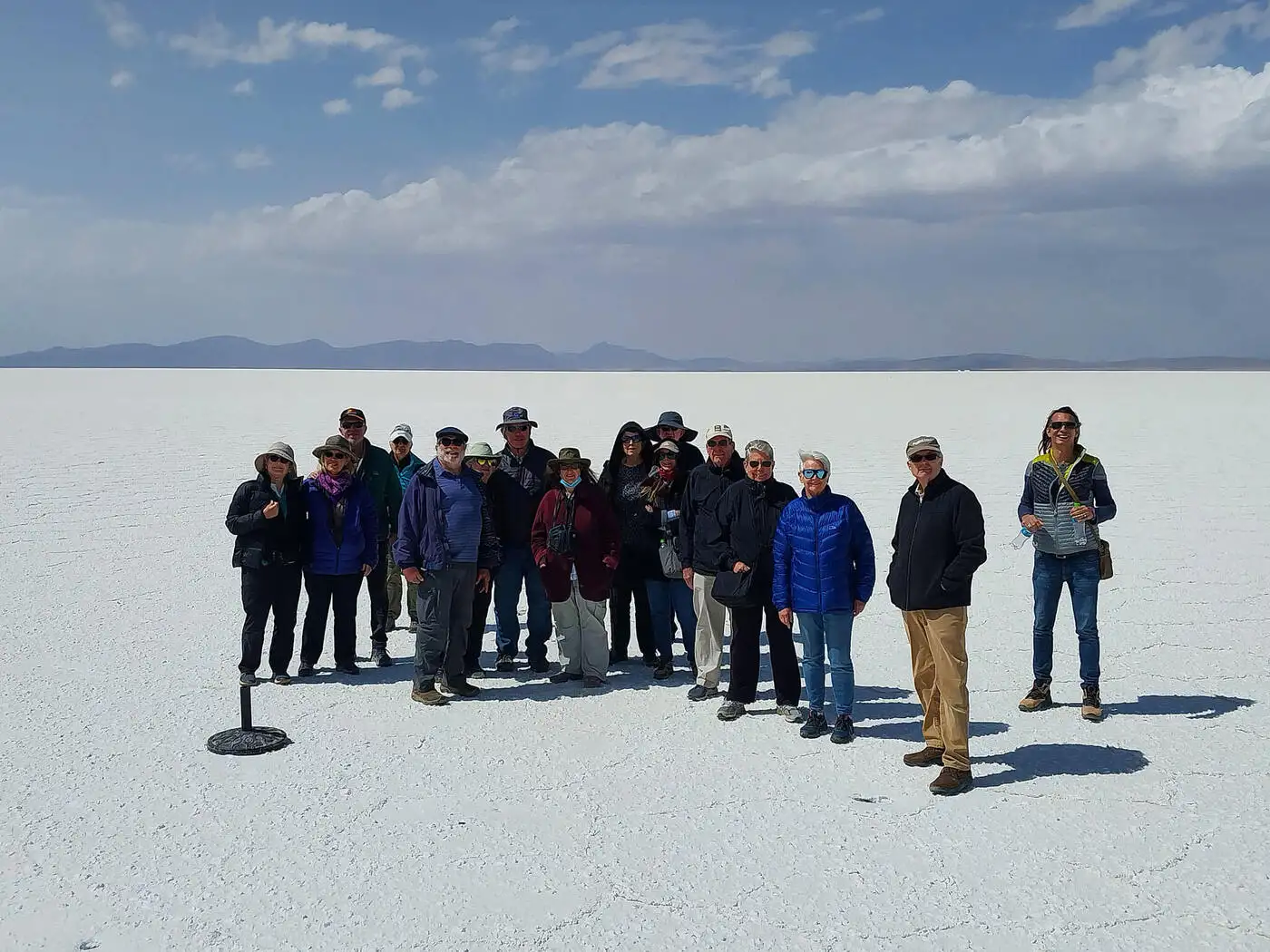
Excellent
Overall Rating
4.6
Extend Your Trip
This tour is part of a series that can be upgraded to make for a longer trip.

Fast and easy
Book this tour
Book your unforgettable adventure today! For any questions or advice, don't hesitate to contact us.
Have questions?
Contact Us
1-800-665-3998
- Final payment is due days prior to departure.
- A non-refundable $500 USD deposit is payable at the time of booking
- Optional Single Supplement: $570 USD (number of singles limited).
- Transferring to another tour or tour date is only permissible outside of 120 days prior to departure and is subject to a $100 USD change fee. (Read our cancellation policy for more info.)
Prices below are per person, twin-sharing costs in US Dollars (USD). Pricing does not include airfare to/from the tour and any applicable taxes. Get general information on flights to/from the tour.
Choose your departure date:
Frequently Asked Questions
- What is the maximum number of participants on a trip?Most of our tours carry a maximum of 18 participants; some tours (ie hiking tours) top out at 16. In the event that we do not achieve our minimum complement by our 90-day deadline, we may offer group members the option of paying a "small-group surcharge" as an alternative to cancellation. If all group members agree, we will confirm the trip at existing numbers; this surcharge is refundable in the event that we ultimately achieve our regular minimum. If the small group surcharge is not accepted, we will offer a refund of your deposit or a different trip of your choice.
- Can I extend my tour either at the beginning or end? What about stopovers?Yes, you can extend your tour either at the beginning or the end and we can book accommodation in our tour hotel. Stopovers are often permitted, depending on air routing. Stopovers usually carry a "stopover" fee levied by the airline.
- How do I make a reservation? How and when do I pay?The easiest way to make a reservation is via our website; during office hours, you are also more than welcome to contact us by telephone.
A non-refundable deposit is payable at the time of booking; if a reservation is made within 90 days, full payment is required. Some trips require a larger deposit. If international airline bookings require a non-refundable payment in order to secure space or the lowest available fare, we will require an increase in deposit equal to the cost of the ticket(s).
Early enrolment is always encouraged as group size is limited and some trips require greater preparation time.
Once we have received your deposit, we will confirm your space and send you a confirmation package containing your trip itinerary, any visa/travel permit related documents, invoice, clothing and equipment recommendations, general information on your destination(s), and forms for you to complete, sign and return to us. Your air e-tickets (if applicable), final hotel list, final trip itinerary, and instructions on how to join your tour, will be sent approximately 2-3 weeks prior to departure. - What about cancellations, refunds, and transfers?Please review our cancellation policy page for details.
- I am a single who prefers my own room. What is a single supplement?All of our tours have a single supplement for those who want to be guaranteed their own room at each location.
This supplement is a reflection of the fact that most hotels around the world do not discount the regular twin-share rate for a room by 50% for only one person occupying a room. Most hotels will give a break on the price, but usually in the range of 25-30% of the twin-share rate. This difference, multiplied by each night, amounts to the single supplement.
The conventional amount can also vary from country to country and some destinations are more expensive than others for single occupancy. In order to be "single friendly," the supplements we apply are not a profit centre for us and we do our best to keep them as reasonable as possible.
On most tours we limit the number of singles available, not to be punitive, but rather because many hotels allow for only a limited number of singles; some smaller hotels at remote locations also have a limited number of single rooms available.
Please note that most single rooms around the world are smaller than twin-share rooms and will likely have only one bed. - Do you have a shared accommodation program?Yes! If you are single traveller and are willing to share, we will do our best to pair you with a same-gender roommate. On most of our tours, if we fail to pair you, we will absorb the single supplement fee and you will default to a single room at no extra charge. At some destinations, however, where single rooms are not significantly discounted, or not at all, we may apply a "mandatory" single in the event that we cannot find you a share partner. This is usually 50% of the usual supplement, but can be as much as 100%. If applicable, this proviso will be noted on each tour page on this website, on your invoice, and in our tour date/price book (available for download under "Resources").
Please choose a departure date!
DATES & PRICES
